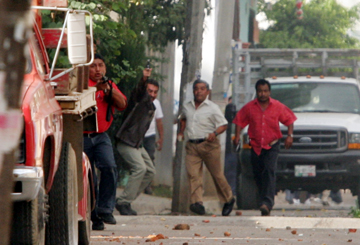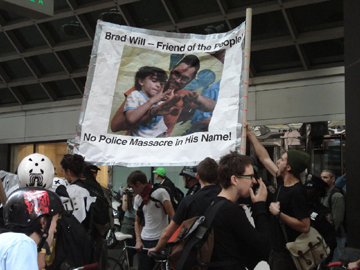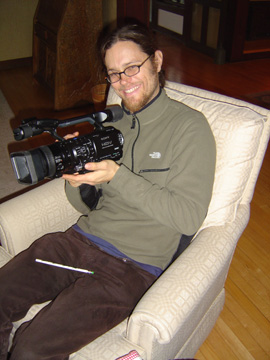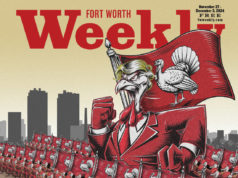OAXACA — Those of us who report from the front lines of the social justice movement in Latin America share an understanding that it’s always possible there are bullets out there with our names on them. Brad Will traveled 2,500 miles, from New York to this violence-torn Mexican town, to find his.
 Throughout the summer and fall of 2006, the southern Mexican state of Oaxaca was on fire. Death squads, the pistoleros of a despised governor, rolled through the cobblestone streets of this colonial state capital, peppering with automatic weapons fire the flimsy barricades erected by masked rebels. Hundreds were killed, wounded, or imprisoned. Will, a New York independent video journalist, felt he had to be there. Xenophobia was palpable on the ground when Will arrived. Foreign journalists were being attacked as terrorists by the governor’s sycophants in the press. Kill any foreigner with a camera, the radio announcers urged.
Throughout the summer and fall of 2006, the southern Mexican state of Oaxaca was on fire. Death squads, the pistoleros of a despised governor, rolled through the cobblestone streets of this colonial state capital, peppering with automatic weapons fire the flimsy barricades erected by masked rebels. Hundreds were killed, wounded, or imprisoned. Will, a New York independent video journalist, felt he had to be there. Xenophobia was palpable on the ground when Will arrived. Foreign journalists were being attacked as terrorists by the governor’s sycophants in the press. Kill any foreigner with a camera, the radio announcers urged.
For much of the afternoon of Oct. 27, Will had been filming armed confrontations on the barricades just outside the city. He was trapped in the middle of a narrow street while gunshots boomed all around him, but he kept filming, looking for the “money shot.” And he found it: On his final bits of tape, you see two killers perfectly framed, their guns firing. You hear the fatal shot and experience Brad’s shudder of dismay as the camera finally tumbles from his hands and bounces along the sidewalk. Photos taken at the same time by El Universal, the Mexican newspaper, show the same gunmen, and they’re perfectly identifiable. By all visible evidence, Brad Will filmed his own murder. But this is Mexico, where justice is spelled i-m-p-u-n-i-t-y — and Will’s apparent killers continue to ride the streets of Oaxaca, free and, it seems, untouchable. Curiously, this egregious murder of a U.S. reporter in Mexico has drawn minimal response from Ambassador Tony Garza, an old crony of George W. Bush. Why this lack of interest? Can it be that Washington has another agenda that conflicts with justice for Brad Will — the impending privatization of Mexican oil?
 Will was once a fire-breathing urban legend on Manhattan’s lower east side. Perching atop the Fifth Street squat where he had lived for years and waving his long arms like Big Bird as the wrecking ball swung in, or dressing as a sunflower and being dragged out of City Hall in an effort to help rescue the neighborhood’s community gardens, this child of privilege from Chicago’s wealthy North Shore was a legitimate street hero in the years before the World Trade Center towers collapsed and the social change movement in New York City went into deep freeze.Will hosted an incendiary weekly show on the pirate station “Steal This Radio” and was an early part of Indymedia, the web publishing experiment born during the World Trade Organization protests that rocked Seattle in 1999. Indymedia describes itself as “a collective of independent media organizations and hundreds of journalists offering grassroots, non-corporate coverage … a democratic media outlet for the creation of radical, accurate, and passionate tellings of truth.”
Will was once a fire-breathing urban legend on Manhattan’s lower east side. Perching atop the Fifth Street squat where he had lived for years and waving his long arms like Big Bird as the wrecking ball swung in, or dressing as a sunflower and being dragged out of City Hall in an effort to help rescue the neighborhood’s community gardens, this child of privilege from Chicago’s wealthy North Shore was a legitimate street hero in the years before the World Trade Center towers collapsed and the social change movement in New York City went into deep freeze.Will hosted an incendiary weekly show on the pirate station “Steal This Radio” and was an early part of Indymedia, the web publishing experiment born during the World Trade Organization protests that rocked Seattle in 1999. Indymedia describes itself as “a collective of independent media organizations and hundreds of journalists offering grassroots, non-corporate coverage … a democratic media outlet for the creation of radical, accurate, and passionate tellings of truth.”
With his long hair neatly tied back and parted down the middle, his granny glasses and fringe beard and fierce commitment to building community, Will seemed to have emerged whole from a more utopian time in America. He was an independent journalist, one of the growing number of people who, like Josh Wolf in San Francisco, use the internet and their own laptops, recorders, and video cameras to track and report on social moments and injustice. Will wore no credential from any major news organization, but using outlets like Indymedia, he and Wolf — who spent seven months in prison to avoid giving the police a copy of his video outtakes — represent part of the future of journalism. Will’s journey to the place where he would die began right after Sept. 11, 2001. Dyan Neary, than a neophyte journalist, met Brad in the elevator coming down from the WBAI radio studios soon after the terrorist attacks. “We walked down the piles. They were still smoking,” she remembered in a phone call from Humboldt County, Calif. “We were both really scared. We thought this was not going to be resolved soon, maybe never. So we thought we should go to Latin America, where people were still fighting.”
Will and Neary spent most of 2002 and 2003 roaming the bubbling social landscape of Latin America. In Fortaleza, Brazil, they confronted the director of the InterAmerican Development Bank during riotous street protests. They journeyed to Bolivia and interviewed Evo Morales, not yet the president, and traveled in the Chapare rainforest region with the coca growers federation. They hung out in Cochabamba with Oscar Oliviera, the hero of the battle to keep Bechtel from taking over that city’s water system. Everywhere they went, they sought out pirate radio projects and offered their support. In February 2005, Will was in Brazil, filming the resistance at a huge squatters’ camp in the state of Goias, when the military police swept in, killing two and jailing hundreds. On his videos, you can hear the live ammunition zinging all around him as he captures the carnage. He was savagely beaten and held by the police — only his U.S. passport saved him.
 Despite the close call, Will was hooked. He soldiered back through Peru and Bolivia and then, out of money, flew back to New York to raise more. In 2006, he ping-ponged back and forth between New York and Latin America — tracking Subcomandante Marcos and the Zapatistas’ “Other Campaign” through Mexico’s Yucatan peninsula, then returning to Brooklyn. (The rent-gougers had forced him out of Manhattan’s lower east side.) Tracking the incipient rebellion in Oaxaca on the internet, he worried, friends said, about being just one more white guy in the way — but eventually, the lure of the action pulled him in. He flew south out of New York on Sept. 29, his return set for Oct. 28. He never made the plane. The mountainous southern state of Oaxaca sits at the top of most of Mexico’s poverty-indicator lists — for infant mortality, malnutrition, unemployment, illiteracy. Human rights violations are rife. It also is home to Mexico’s heaviest concentration of indigenous peoples, with 17 distinct Indian cultures, each with a rich tradition of resistance to the dominant white and mestizo overclass. Oaxaca vibrates with class and race tensions that cyclically erupt into uprising and repression.
Despite the close call, Will was hooked. He soldiered back through Peru and Bolivia and then, out of money, flew back to New York to raise more. In 2006, he ping-ponged back and forth between New York and Latin America — tracking Subcomandante Marcos and the Zapatistas’ “Other Campaign” through Mexico’s Yucatan peninsula, then returning to Brooklyn. (The rent-gougers had forced him out of Manhattan’s lower east side.) Tracking the incipient rebellion in Oaxaca on the internet, he worried, friends said, about being just one more white guy in the way — but eventually, the lure of the action pulled him in. He flew south out of New York on Sept. 29, his return set for Oct. 28. He never made the plane. The mountainous southern state of Oaxaca sits at the top of most of Mexico’s poverty-indicator lists — for infant mortality, malnutrition, unemployment, illiteracy. Human rights violations are rife. It also is home to Mexico’s heaviest concentration of indigenous peoples, with 17 distinct Indian cultures, each with a rich tradition of resistance to the dominant white and mestizo overclass. Oaxaca vibrates with class and race tensions that cyclically erupt into uprising and repression.
The Party of the Institutional Revolution, or PRI, ruled Mexico for most of the last century, until its corrupt dynasty was overthrown in 2000 by the right-wing National Action Party (PAN) and its picaresque presidential candidate, Vicente Fox, former president of Coca Cola-Mexico. But in Oaxaca, the PRI never lost power. While voters all over the country were throwing off its yoke, Oaxaca was electing that party’s Ulises Ruiz Ortiz — known as URO — in a fraud-marred gubernatorial election in 2004. In the first 16 months of his regime, Ruiz proved spectacularly unresponsive to the demands of the popular movements for social justice. He turned a deaf ear in May 2006, when a militant local of the National Education Workers Union known as Section 22 presented its contract demands. A week later, tens of thousands of teachers took over Oaxaca’s plaza and 52 surrounding blocks and set up a ragtag tent city. Each morning, the maestros would march out of their camp and block highways and government buildings, which were soon smeared with anti-URO slogans.
Ruiz retaliated before dawn on June 14, sending a thousand heavily armed police into the plaza to evict the teachers. Low-flying helicopters sprayed pepper gas on the throng below. From the balconies of colonial hotels that surround the plaza, police tossed down concussion grenades. Radio Planton, the maestros’ pirate station, was demolished and the tent city set afire. A pall of black smoke hung over the city. Four hours later, community members and striking teachers, armed with clubs and Molotov cocktails, overran the plaza and sent URO’s cops packing. No uniformed police officers would be seen on the streets of Oaxaca for many months. And on June 16, two days after the monumental battle, 200,000 Oaxacans marched through the city to repudiate the governor’s “hard hand.” The demonstration reportedly extended for more than six miles. John Gibler, who closely covered the Oaxaca uprising as a fellow for the international human rights organization Global Exchange, wrote that the surge of rebels on June 14 soon transformed itself into a popular assembly. The Oaxaca Peoples Popular Assembly or APPO was formally constituted a week later. It would have no leaders but many spokespersons, with all decisions to be made in popular assemblies.
For the next several weeks, APPO and Section 22 would paralyze Oaxaca — but the rest of Mexico took little notice. Instead, the nation was hypnotized by the suspect July 2 presidential election in which a right-wing PANista, Felipe Calderón, was awarded a narrow victory over coalition candidate and leftist Andrés Manuel López Obrador. When López Obrador cried foul, millions poured into the streets, in the most massive political demonstrations in Mexican history. Oaxaca seemed like small potatoes. But Oaxaca is an international tourist destination, and the APPO and Section 22 had closed down the tourist infrastructure, blocking the airport and forcing five-star hotels to shut their doors. On July 17, Ruiz was forced to announce the cancellation of the “Guelaguetza,” a dance festival that has become Oaxaca’s premier tourist attraction. Ruiz began to fight back.
During the first weeks of August, he launched what came to be known as the “Caravan of Death” — a train of 30 or 40 private and government vehicles, rolling nightly, filled with city and state police officers firing on the protesters. To keep the Caravan of Death from moving freely through the city, the APPO and the maestros threw up a thousand or more barricades in the working-class neighborhoods of the city and its suburbs. The rebels piled up dead trees, old tires, and the carcasses of cars and buses, and the barriers soon took on their own life. Murals were painted with the ashes of the bonfires that burned atop the piles, and the barricades lent an air of the Paris Commune to Oaxaca’s struggle. An uneasy lull had gripped the city when Brad Will arrived at the bus terminal on the first of October and found himself a cheap room. But the break wouldn’t last long.
Like most non-Mexicans who style themselves independent reporters, Will had no Mexican press credential and only a tourist visa, meaning he was working illegally and susceptible to deportation. But he got himself accredited by Section 22 and wore the rebel group’s credential around his neck with his Indymedia press card. On Oct. 14, APPO militant Alejandro García Hernández was killed at a barricade downtown. Will joined an angry procession to the Red Cross hospital where the dead man had been taken. In his last dispatch, on Oct. 16, Will’s words caught this very Mexican whiff of death: “Now [Alejandro] lies there waiting for November 2nd, the Day of the Dead, when he can sit with his loved ones again to share food and drink and song,” he wrote. “One more death. … One more time to know power and its ugly head.” The dynamic in Oaxaca had gotten “sketchy,” Will wrote to Neary. A Section 22 leader had cut a deal with the outgoing Fox government and forced a back-to-work vote Oct. 21 that narrowly carried, amid charges of sell-outs and pay-offs. If the teachers went back to work, the APPO would be alone on the barricades and even more vulnerable to Ruiz’ gunmen. But backing down is not in the Popular Assembly’s dictionary, and the APPO voted to ratchet up the lucha (struggle) and make Oaxaca really ungovernable.
Mobile brigades were formed — young toughs armed with lead pipes and boards with nails driven through them who hijacked what buses were still running, forced the passengers off, and rode around looking for action. Later, the buses were set afire. The barricades were reinforced to shut down the capital beginning Oct. 27. The escalation proved to be a terrible mistake. Up in Mexico City, the post-electoral turmoil had finally subsided, and PAN was ready to deal with the PRI. It wasn’t a good time for inexperienced foreigners. Ruiz’ people were checking the guest lists at the hostels for “inconvenient” internationals. Immigration authorities threatened extranjeros with deportation if they joined the protests. The local U.S. consul, Mark Leyes, warned Americans that he would not be able to help them out if they got caught up in the maelstrom.
To add to this malevolent ambiance, a new pirate radio station popped up at 99 on the FM dial. Radio Ciudadana — Citizens Radio — announced it was broadcasting “to bring peace to Oaxaca” and to celebrate the honor of “our macho, very macho governor.” The announcers, who seemed to have Mexico City accents, let loose a torrent of vitriol — stuff like “we have to kill the mugrosos [dirty ones] on the barricades.” The extranjeros, the radio said, were stirring up all the trouble. “They pretend to be journalists, but they have come to teach terrorism classes.
More frightening was this admonition: “Si ves a un gringo con cámara, mátalo!” — literally, “If you see gringo with a camera, kill him!” This poison spewed out of local radios all day Oct. 26 and 27, but whether Will heard — or understood — the warnings is unclear. He didn’t speak much Spanish.











